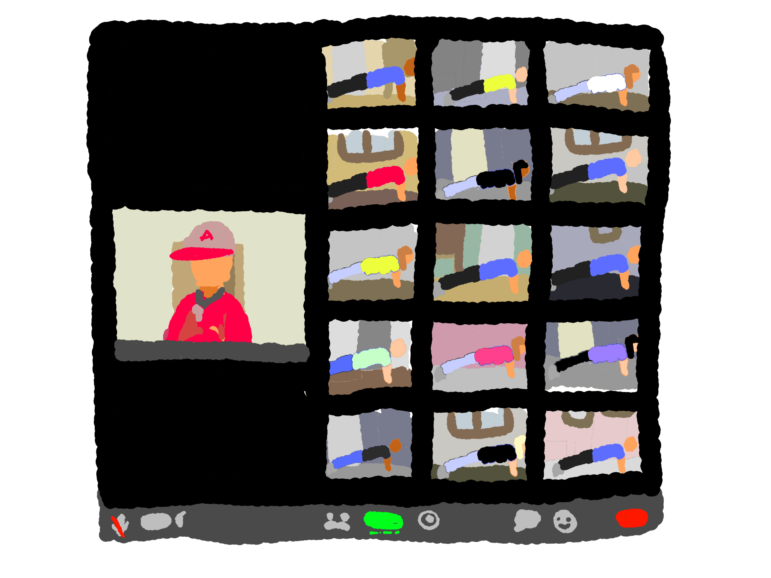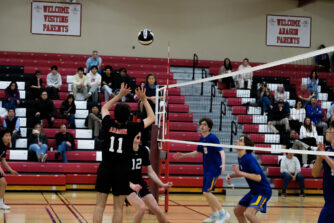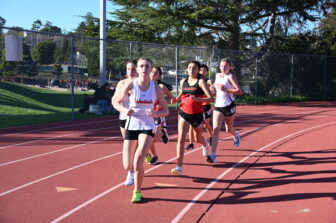

COVID-19 has spread through schools nationwide, leaving adverse and unprecedented effects on physical education courses, a class many students saw as a relief from academics and a time for exercise with friends.
For incoming freshmen, their first semester of high school physical education has typically included running around Aragon’s track, being introduced to new activities and swimming. For sophomores, it meant another year of engaging in new sports and honing skills of fitness.
“The actual ability to be outside at the track for a run, on the courts for tennis, on the field for soccer, in the gym for badminton and in the pool for swimming is priceless,” said PE teacher Guy Oling. “The in-person ability to demonstrate a skill or interact by discussion or assessment is so important.”
Exercise is vital to mental health as well. However, guidelines from the San Mateo Union High School District have put in-person classes on pause. The wrestling mats are gathering dust, gyms are without the cheers of fervent sports fans and pools are vacant.
Distance learning has negatively affected teachers and students alike. Uncertainties surrounding new applications for fitness and different platforms for teaching have left both wondering what comes next.
“The most difficult part was all [of] the sudden just being thrust into [distance learning] and [having to change] from something that we were allowed to do everyday,” said PE department head Annette Gennaro. “That social part of PE [is] really important. … [It] really got lost once we had to switch to distance learning.”
“I absolutely 100% miss those relationships, being able to talk to students. Whether it’s just a high five or someone’s got an issue and they need just an adult to talk to“
Distance learning for PE during the spring semester primarily centered around asynchronous activity using MapMyFitness, a mobile app that tracks workouts. However, this semester, teachers opted to use different apps as well as a form of synchronous learning through Zoom.
PLT4M is an educational and athletic app that teachers are using this year so students can watch instructional videos on a certain unit. For example, videos provided by PLT4M on the fitness unit — which will continue during distance learning — can help correct posture and recommend workouts. Workout reports from this app are not directly linked to Canvas; instead, students submit screenshots or other evidence from PLT4M.
The 337 Aragon students who requested to engage through independent PE study are using Edgenuity, an online learning platform accredited by the Western Association of Schools and Colleges, because of its user-friendly interface and flexibility in course modification. Edgenuity was approved by the Board of Trustees in 2018 as an option for credit recovery, but this year will be its first appearance in PE classes.
During distance learning, there will be an emphasis on knowledge of psychological and sociological concepts, principles and strategies that apply to physical activity, in accordance with California Content Standard Three for physical education. Teachers have added social-emotional learning as a focus for the fall semester, covering growth mindset and self-awareness, among other topics.
If students return to school this academic year, PE will shift to California Content Standard One, which has more movement-based activities. Units such as swimming, self-defense and pickleball could then be introduced.
Throughout the summer, PE department heads Genarro and Linda Brown met with the department heads of Hillsdale, San Mateo, Capuchino, Mills and Burlingame to map out a semester course for their students. Through a mixture of social-emotional learning and various different apps, everything in the curriculum was scaffolded.
“The goal this summer wasn’t really about coming back to school; [it] was to make sure that we had a robust curriculum for distance learning,” Gennaro said. “I think going back to school … is really important. … I think [the district will] be very open with providing ideas on how to come back and making sure it’s safe.”
The district also offered professional development this summer, where department heads decided that ninth and 10th grade curricula would be the same. Because sophomores lost almost half of their school year due to campus closures last spring, their PE education is largely incomplete. By merging underclassmen curricula, teachers are able to get sophomores on the right track and help freshmen start from square one. Some units, such as combatives and self defense, can be done at home through individualized activities.
Despite teachers’ best efforts, distance learning pales in comparison to physical engagement.
“As PE teachers, we’re very outgoing; we interact with our students every day. I absolutely 100% miss those relationships, being able to talk to students. Whether it’s just a high five or someone’s got an issue and they need just an adult to talk to,” said PE teacher Michael Flynn. “Using Zoom will at least allow us some interaction and engagement with students this year, but nothing can replace being at school and working with students on a day-to-day basis.”
Students have also felt the same difficulties in their experiences with online learning.
“Honestly, [PE is] easier [with] less workout and less exercise, which I know a lot of students are happy about,” said sophomore Andre Wang. “But I feel like it’s missing that in-class feeling [where] your teacher gets to help you out on anything when you’re working. I feel like all the teachers are putting in some pretty good effort to help us out and be connected.”
While both students and teachers are doing their best to adapt, technological and engagement difficulties will inevitably arise.
“I just hope that the students go into the semester with an open mind. It’s going to be a learning process, not only for the students, but for the teachers,” Flynn said. “There’s going to be some bumps in the road, but we’ll get through it and stay positive. … I’m hoping that we’ll be able to see [our students] soon on campus in a fully functioning class.”
“There’s going to be some bumps in the road, but we’ll get through it and stay positive.“
Distance learning has taken away the social aspect of PE, but it guarantees the health of students and staff. Despite the difficulties that come with online learning, teachers are adapting and striving to make it a positive experience for all.
Additional reporting by Elizabeth van Blommestein.



